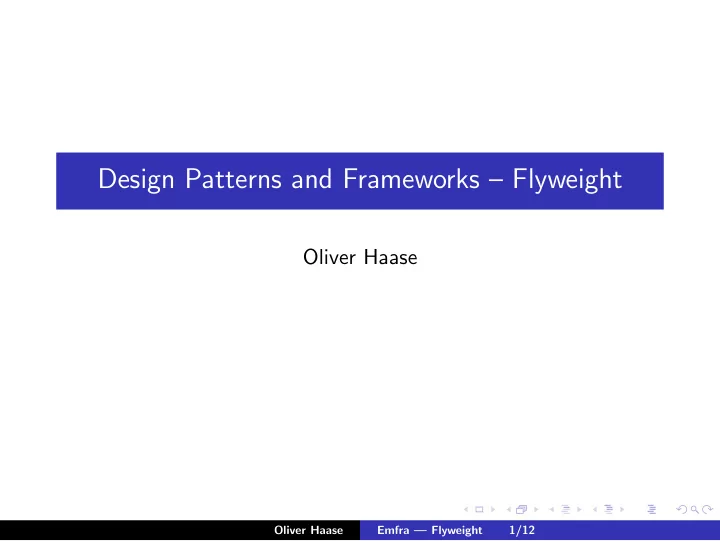

Design Patterns and Frameworks – Flyweight Oliver Haase Oliver Haase Emfra — Flyweight 1/12
Description ◮ Classification : Object-based structural pattern ◮ Purpose : Use small-grained objects together, to avoid instantiation of a large number of objects. “Any fool can write code that a computer can understand. Good programmers write code that humans can understand.” — Martin Fowler. Oliver Haase Emfra — Flyweight 2/12
Motivation ◮ Imagine a text processor that represents text documents consisting of pages, rows, words, and characters . ◮ for homogeneity, it would be nice to treat the concepts of pages, rows, words, and characters similarly, in particular as objects . ◮ Problem : A book with 300 pages can easily contain 840 000 characters → huge overhead if modelled as 840 000 regular objects! Oliver Haase Emfra — Flyweight 3/12
Idea ◮ Divide object state into intrinsic and extrinsic state, such that there is only a small number of distinct objects with different intrinsic states. ◮ Share these flyweight objects. ◮ Feed them with extrinsic state for operation invocations. Character Flyweight Objects intrinsic state : character code (e.g. Unicode) extrinsic state : font, text style (bold, italics, regular), position Oliver Haase Emfra — Flyweight 4/12
Description ◮ Applicability : Use the flyweight pattern only if all of the following apply ◮ An application uses a large number of objects. ◮ The memory consumption forbids instantiation of individual objects. ◮ A big part of the object state can be moved into the context (can be made extrinsic). ◮ Removal of the extrinsic state results in a small number of distinct objects. ◮ Thr application does not depend on the object identity. Oliver Haase Emfra — Flyweight 5/12
Structure Oliver Haase Emfra — Flyweight 6/12
Participants ◮ Flyweight : declares operations that get fed with the extrensic state ◮ ConcreteFlyweight : ◮ implements the Flyweight interface ◮ keeps the intrinsic state of the (shared) object ◮ UnsharedConcreteFlyweight : Possibly, some implementations of Flyweight are not shared — typically more coarse-grained objects on a higher layer of the application. The objects can keep not only their intrinsic, but their complete state. ◮ FlyweightFactory : creates and maintains the flyweight objects. ◮ Client : ◮ has references to the flyweight objects ◮ keeps or computes the objects’ extrinsic state Oliver Haase Emfra — Flyweight 7/12
Interactions ◮ Intrinsic and extrinsic state must be clearly distinguishable. Flyweight objects store intrinsic state, clients store or compute extrinsic state and supply it into flyweight’s operations. ◮ Clients don’t create flyweight objects directly. A flyweight factory makes sure flyweight objects are correctly shared. Oliver Haase Emfra — Flyweight 8/12
Consequences ◮ Reduced memory consumption comes at the cost of increased runtime, because client has to compute or access stored extrinsic state information, and pass it into flyweight objects. ◮ Memory saving depends on ◮ degree of reduction of objects; ◮ size of intrinsic state; ◮ whether extrinsic state is stored or calculated. Oliver Haase Emfra — Flyweight 9/12
Extrinsic State ◮ Applicability depends on how easily extrinsic state information can be identified and pulled out. ◮ Benefit (in terms of memory consumption) depends on whether the amount of extrinsic state for all flyweight objects equals the original state information or not. Example → character flyweight objects: intrinsic state : Character code (e.g. Unicode) extrinsic state : font, text style, position Client doesn’t have to store font and text style per flyweight object, but stores these attributes per bigger chunks of text. Oliver Haase Emfra — Flyweight 10/12
Related Patterns ◮ Flyweight often combined with composite pattern , to build hierarchy of objects with shared (flyweight) leaves. ◮ → State and → Strategy objects are preferably implemented as flyweight objects. Oliver Haase Emfra — Flyweight 11/12
Closing Remarks ◮ Normally, patterns are intended to keep design simply, to reduce dependencies, to reduce number of classes, etc. → simplicity , clarity , maintainability , & friends ◮ sometimes — though not always — at the expense of reduced efficiency ◮ In contrast, flyweight pattern motivated by efficiency considerations → relevance can be expected to decrease as main memory continously gets cheaper Oliver Haase Emfra — Flyweight 12/12
Recommend
More recommend